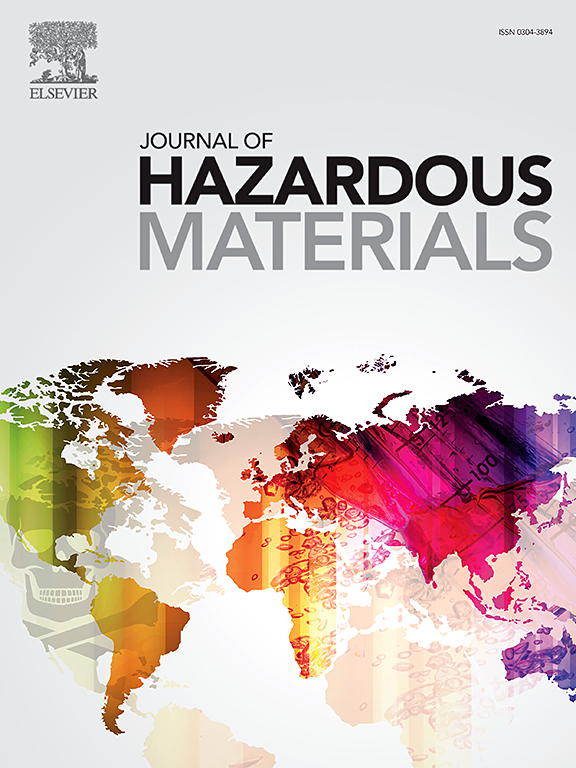Thermally Enhanced Biodegradation Mechanisms of Trichloroethene and Benzene Co-contaminants in Groundwater: Insights into Microbial Functional Gene Enrichment and Biogeochemistry
IF 11.3
1区 环境科学与生态学
Q1 ENGINEERING, ENVIRONMENTAL
引用次数: 0
Abstract
A series of thermally enhanced biodegradation (TEB) experiments at varying temperatures (15, 30 and 45 °C) were conducted to evaluate their effects on the biodegradation kinetics of trichloroethene (TCE) and benzene co-mingled contaminants using indigenous microbial consortiums. Results demonstrated that the highest TCE biodegradation rate, 0.35 mol L⁻¹ day⁻¹, with a half-life of 49 days, was observed at 30 °C, whereas the biodegradation of benzene was enhanced to a less extent. The functional gene analysis results revealed that increased tceA and tmoA genes contributed to enhanced TCE and benzene biodegradation at 30 °C, respectively. Additionally, the reduced vcrA and bvcA abundance and lack of effective electrons may attribute to the cis-1,2-dichloroethylene stalling and low concentration of ethene. Moreover, the biogeochemical analyses confirmed that elevated temperature promoted denitrification and sulfate reduction processes, which expedited methanogenesis, leading to the enhanced dechlorination of TCE. Additionally, the abiotic degradation of TCE facilitated by FeS, evidenced by acetylene and ethene detections, also contributed to the observed enhanced TCE degradation. The study shed lights on the role of temperature in enriching microbial functional gene and influencing biogeochemical conditions for the simultaneous anaerobic biodegradation of TCE and benzene. The findings demonstrated that optimized thermal treatments can effectively bioremediate chlorinated and aromatic hydrocarbons in groundwater.

地下水中三氯乙烯和苯共污染物的热强化生物降解机制:微生物功能基因富集和生物地球化学的见解
通过不同温度(15℃、30℃和45℃)下的热强化生物降解(TEB)实验,评价了其对本地微生物群落对三氯乙烯(TCE)和苯混合污染物的生物降解动力学的影响。结果表明,在30°C条件下,TCE的生物降解率最高,为0.35 μmol L - 1天(49天),而苯的生物降解增强程度较小。功能基因分析结果显示,tceA和tmoA基因的增加分别促进了30°C下TCE和苯的生物降解。此外,vcrA和bvcA丰度的降低和有效电子的缺乏可能是由于顺-1,2-二氯乙烯的失速和低浓度的乙烯所致。此外,生物地球化学分析证实,温度升高促进了反硝化和硫酸盐还原过程,从而加速了甲烷的生成,导致TCE的脱氯作用增强。此外,乙炔和乙烯检测表明,FeS促进了TCE的非生物降解,也促进了TCE的降解。该研究揭示了温度在富集微生物功能基因和影响TCE和苯同时厌氧生物降解的生物地球化学条件中的作用。结果表明,优化后的热处理能有效地生物修复地下水中的氯代烃和芳烃。
本文章由计算机程序翻译,如有差异,请以英文原文为准。
求助全文
约1分钟内获得全文
求助全文
来源期刊

Journal of Hazardous Materials
工程技术-工程:环境
CiteScore
25.40
自引率
5.90%
发文量
3059
审稿时长
58 days
期刊介绍:
The Journal of Hazardous Materials serves as a global platform for promoting cutting-edge research in the field of Environmental Science and Engineering. Our publication features a wide range of articles, including full-length research papers, review articles, and perspectives, with the aim of enhancing our understanding of the dangers and risks associated with various materials concerning public health and the environment. It is important to note that the term "environmental contaminants" refers specifically to substances that pose hazardous effects through contamination, while excluding those that do not have such impacts on the environment or human health. Moreover, we emphasize the distinction between wastes and hazardous materials in order to provide further clarity on the scope of the journal. We have a keen interest in exploring specific compounds and microbial agents that have adverse effects on the environment.
 求助内容:
求助内容: 应助结果提醒方式:
应助结果提醒方式:


